History
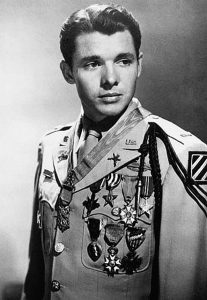 Recently, I found out that I am related to Audie Murphy, who was one of the most decorated American combat soldiers in World War II. As it turns out, he is my 7th cousin 3 times removed, on my dad’s side of the family. We share the same grandfather, Thomas Fuller, who is my 9th great grandfather, and Audie’s 7th great grandfather. Audie became an actor in 1948 and 1969, during which time he was beloved by many people, including my parents. I think they would have been very excited to find out that he was actually related to them, but then I guess they already know it by now. While his acting was impressive, it was his military career that always impressed my parents.
Recently, I found out that I am related to Audie Murphy, who was one of the most decorated American combat soldiers in World War II. As it turns out, he is my 7th cousin 3 times removed, on my dad’s side of the family. We share the same grandfather, Thomas Fuller, who is my 9th great grandfather, and Audie’s 7th great grandfather. Audie became an actor in 1948 and 1969, during which time he was beloved by many people, including my parents. I think they would have been very excited to find out that he was actually related to them, but then I guess they already know it by now. While his acting was impressive, it was his military career that always impressed my parents.
Audie Leon Murphy, was born on June 20, 1925 to Josie Bell Killian and Emmett Berry Murphy in Kingston, Texas. He was born into a large family of sharecroppers. Before long, his father abandoned them, and then his mother died when he was a teenager. Murphy left school in fifth grade to pick cotton and find other work to help support his family. He was a skilled rifleman, and hunting became a necessity for putting food on the table.
After the Japanese attacked Pearl Harbor in 1941, Murphy’s decided that he wanted to help, but he was too young. His older sister helped him to falsify documentation about his birthdate in order to meet the minimum-age requirement for enlisting in the military, because he was only 16 at the time. He was turned down by the Navy and the Marine Corps, so he enlisted in the Army. He first saw action in the 1943 Allied invasion of Sicily. Then, in 1944 he participated in the Battle of Anzio, the liberation of Rome, and the invasion of southern France. Murphy fought at Montélimar and led his men on a successful assault at the L’Omet quarry near Cleurie in northeastern France in October. He received every military combat award for valor available from the U.S. Army, as well as French and Belgian awards for heroism. Murphy received the Medal of Honor for valor that he demonstrated at the age of 19 for single-handedly holding off an entire company of German soldiers for an 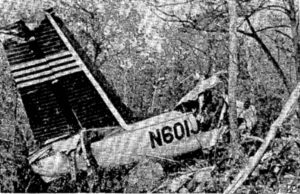 hour at the Colmar Pocket in France in January 1945, then leading a successful counterattack while wounded and out of ammunition.
hour at the Colmar Pocket in France in January 1945, then leading a successful counterattack while wounded and out of ammunition.
After his acting career ended, Murphy, like many actors without work, experienced money problems, but still, he refused offers to appear in alcohol and cigarette commercials, because he did not want to set a bad example. He never let Hollywood take away his high moral standards. Murphy died in a plane crash in Virginia in 1971, shortly before his 46th birthday. Such a sad ending to an amazing life. He was interred with full military honors at Arlington National Cemetery. His grave is one of the most visited sites in the cemetery.
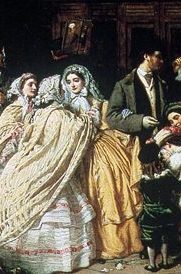 These days, with all the television shows about secret agents, undercover cops, and spies, most of us wouldn’t think twice about one of those positions being held by a woman. During the American Civil War, however, which basically coincided with the Victorian era, one of the most morally repressive eras in history for women, things were different. Everything from a woman’s dress to her education were tightly constricted by moral attitudes that governed her every action. Basically, women were to concentrate their “war efforts” on the task of supporting their husband, brothers, or fathers, in whatever their beliefs were toward the matter. However, as the war dragged on and more men were called into active duty, the farms, factories, stores, and schools were left without workers, so the women stepped up to stand in the gap, as it were. This was most surprising because, back then, women were considered too frail, and their minds too simple for things like politics and war. They were designed for keeping the home and taking care of the babies. Nevertheless, when the men were called into active duty, most of them would have lost their farms, homes, and businesses had it not been for the strength and intelligence of the of the “frail and simple” women. Many women refused to limit their assistance to their country to what could be accomplished close to home. Some of them became nurses, worked to raise supplies for their troops, or even worked in armories, but there was a number of these women decided to support their country in a more dangerous…and scandalous way…they became spies.Back then, espionage was considered a very dishonorable pursuit for a man during the Civil War era, but for a woman…it was tantamount to prostitution. Nevertheless, with the war raging, women of both the North and South flaunted the Victorian morality of the time to provide their country the intelligence it needed to make tactical and practical decisions.
These days, with all the television shows about secret agents, undercover cops, and spies, most of us wouldn’t think twice about one of those positions being held by a woman. During the American Civil War, however, which basically coincided with the Victorian era, one of the most morally repressive eras in history for women, things were different. Everything from a woman’s dress to her education were tightly constricted by moral attitudes that governed her every action. Basically, women were to concentrate their “war efforts” on the task of supporting their husband, brothers, or fathers, in whatever their beliefs were toward the matter. However, as the war dragged on and more men were called into active duty, the farms, factories, stores, and schools were left without workers, so the women stepped up to stand in the gap, as it were. This was most surprising because, back then, women were considered too frail, and their minds too simple for things like politics and war. They were designed for keeping the home and taking care of the babies. Nevertheless, when the men were called into active duty, most of them would have lost their farms, homes, and businesses had it not been for the strength and intelligence of the of the “frail and simple” women. Many women refused to limit their assistance to their country to what could be accomplished close to home. Some of them became nurses, worked to raise supplies for their troops, or even worked in armories, but there was a number of these women decided to support their country in a more dangerous…and scandalous way…they became spies.Back then, espionage was considered a very dishonorable pursuit for a man during the Civil War era, but for a woman…it was tantamount to prostitution. Nevertheless, with the war raging, women of both the North and South flaunted the Victorian morality of the time to provide their country the intelligence it needed to make tactical and practical decisions.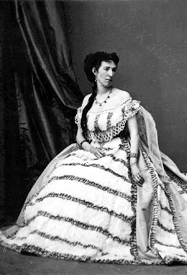
The most famous of these female spies was Belle Boyd…born Marie Isabella Boyd. She began spying for the Confederacy when Union troops invaded her Martinsburg, Virginia home in 1861. One of the Federal soldiers manhandled her mother, and Boyd shot and killed him. She was exonerated in the soldier’s death, and an emboldened Boyd managed to befriend the Union soldiers left to guard her, and used her slave, Eliza, to pass information confided in her by the soldiers along to Confederate officers. Boyd was caught at her first attempt at spying, and threatened with death, but she did not stop her activities. She vowed to find a better way instead. She began eavesdropping on union officers staying at her father’s hotel. She learned enough to inform General Stonewall Jackson about their regiment and activities. Taking no chances, this time, Boyd delivered her intelligence firsthand, moving through Union lines, and reportedly drawing close enough to the action to return with bullet holes in her skirts. The information she provided allowed the Confederate army to advance on Federal troops at Fort Royal. Boyd’s daring acts of espionage soon caught up with her again and when a beau gave her up to Union authorities in 1862, she was arrested and held in the Old Capitol Prison in Washington for a month. Then she released, but found herself in the arrested again soon after. Once again, she managed to be set free, and this time she traveled to England, where amazingly, she married not a Confederate soldier, but a Union officer.
Boyd wasn’t the only spy in the Civil War. Another famous female spy was nicknamed “Crazy Bet,” but her real 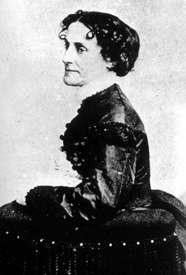 name was Elizabeth Van Lew. Van Lew was born to a wealthy and prominent Richmond family, and was educated by Quakers in Philadelphia. When she returned to Richmond, she had become an abolitionist. She even went so far as to convince her mother to free the family’s slaves. Her espionage activity began soon after the start of the war. Her neighbors were appalled, because she openly supported the Union. She concentrated her efforts on aiding Federal prisoners at the Libby Prison, by taking them food, books, and paper. Later, she smuggled information about Confederate activities from the prisoners to Union officers, including General Ulysses S. Grant. To hide her activities from her Confederate neighbors, she behaved oddly. She dressed in old clothes, talking to herself, and refusing to comb her hair. Believe it or not, people began to think she was insane. They started calling her “Crazy Bet.” Van Lew wasn’t insane, in fact, she was incredibly intelligent. She was hailed by Grant as the provider of some of the most important intelligence gathered during the war.
name was Elizabeth Van Lew. Van Lew was born to a wealthy and prominent Richmond family, and was educated by Quakers in Philadelphia. When she returned to Richmond, she had become an abolitionist. She even went so far as to convince her mother to free the family’s slaves. Her espionage activity began soon after the start of the war. Her neighbors were appalled, because she openly supported the Union. She concentrated her efforts on aiding Federal prisoners at the Libby Prison, by taking them food, books, and paper. Later, she smuggled information about Confederate activities from the prisoners to Union officers, including General Ulysses S. Grant. To hide her activities from her Confederate neighbors, she behaved oddly. She dressed in old clothes, talking to herself, and refusing to comb her hair. Believe it or not, people began to think she was insane. They started calling her “Crazy Bet.” Van Lew wasn’t insane, in fact, she was incredibly intelligent. She was hailed by Grant as the provider of some of the most important intelligence gathered during the war.
 On this day, August 21, 1959, the United States as we know it was completed with the addition of the 50th State… Hawaii. It is the only state that is completely comprised of islands…volcanic islands. Hawaii has another unique feature besides being an island state. That unique feature is that it is the only state that is naturally increasing in size. Most of us immediately think of the current eruptions of Kilauea, and that is a big part of the grown of Hawaii, but it is not the only cause of the growth.
On this day, August 21, 1959, the United States as we know it was completed with the addition of the 50th State… Hawaii. It is the only state that is completely comprised of islands…volcanic islands. Hawaii has another unique feature besides being an island state. That unique feature is that it is the only state that is naturally increasing in size. Most of us immediately think of the current eruptions of Kilauea, and that is a big part of the grown of Hawaii, but it is not the only cause of the growth.
Not every addition to the Big Island involves an eruption that puts people at risk and engulfs their communities. For decades, Kilauea has experienced continuous lava flows through a vent called Pu?u ???? in Hawaii Volcanoes National Park, incrementally adding land to the southeast portion of the island. This continuous flow has added 570 acres of land to Hawaii’s Big Island since 1983, according to the U.S. Geological Survey’s most recent 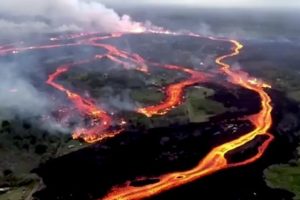 update. Unfortunately, the lava has also buried over 40 square miles of rain forest, communities, and historical sites. Hawaii is an ever-changing place, and the lava doesn’t care about such things as rain forests, communities, and historical sites.
update. Unfortunately, the lava has also buried over 40 square miles of rain forest, communities, and historical sites. Hawaii is an ever-changing place, and the lava doesn’t care about such things as rain forests, communities, and historical sites.
The current stories of the eruption of Kilauea has continued to shock the world, but in reality, Kilauea has been continuously erupting since 1983. Still, on May 3, 2018, the volcano erupted dramatically. The eruption occurred several hours after a magnitude-5.0 quake struck the Big Island. With the eruption came lava flows into residential subdivisions in the Puna district of the Big Island. This prompted mandatory evacuations of the Leilani Estates and Lanipuna Gardens subdivisions. Scientists have two theories about the formation of the Hawaiian Islands. Unlike most volcanoes, the Hawaiian chain sits squarely in the middle of the Pacific plate rather than on a tectonic boundary.
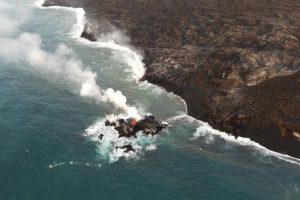
In 1963, J Tuzo Wilson proposed the “hotspot theory” to explain this unusual placement. Wilson proposed that the linear geography of the Hawaiian Islands is due to the movement of the Pacific plate over a stationary point of great heat from deep within the Earth. I have to wonder if that movement is exactly what is causing the current continuing flow of lava from Kilauea. I seems to me that it would be difficult for the lava flow to seal itself when the fault keeps breaking the seal. I could be totally wrong, or I could just be looking at this in a far too simplistic manner. Nevertheless, it seems logical to me. Or maybe that is exactly what Wilson was saying.
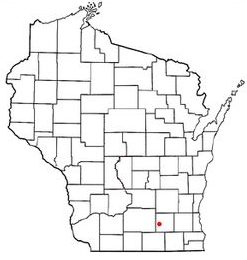 When we think of rain showers, most of us think of a pleasant spring or summer afternoon when the day is hot, and the rain cools things down, and everything smells so good, but on a beautiful April day in 1897 in Jefferson County, Wisconsin, and particularly in the town of Palmyra, the shower they received was not so pleasant. That morning, after a shower overnight, residents woke up expecting to see puddles of rainwater here and there, but instead the sight they saw was appalling. It was like nothing they had ever seen before.
When we think of rain showers, most of us think of a pleasant spring or summer afternoon when the day is hot, and the rain cools things down, and everything smells so good, but on a beautiful April day in 1897 in Jefferson County, Wisconsin, and particularly in the town of Palmyra, the shower they received was not so pleasant. That morning, after a shower overnight, residents woke up expecting to see puddles of rainwater here and there, but instead the sight they saw was appalling. It was like nothing they had ever seen before.
On the ground, the cars, and every other surface in the area were thousands of worms…and they weren’t worms anyone knew about. They were a strange species that was unknown to the area. There was no place that the people could walk without stepping on the disgusting worms. People even had them in barrels that were designed to catch rainwater for drinking, so the drinking water was compromised too. Finally an expert fisherman and gardener, named Captain McDonald, told the people that they were Gilt-Edge Worms. He said that he could tell by their yellow and gold spots and rings. He said that he had used these particular worms for bait while fishing in Ireland.
Well, that was one thing, but Wisconsin is nowhere near Ireland, so how did they get there? Well, the people started to speculate that somehow the worms must have drifted across the ocean in a cloud, but when you think about it, that is an odd thought. Nevertheless, after having watched a story on The Weather Channel about a town that had fish fall out of the sky one time, and that they thought it might have been from a water spout that had scooped them up from a nearby water source, I suspect that something similar might have happened, although I don’t know if the same thing could have happened with a tornado over land, because I doubt if the Gilt-Edge Worm is a water dwelling creature. I don’t suppose they will ever know exactly how the incredible worm shower happened for sure, but while it was a disgusting situation at the time, the townspeople soon decided 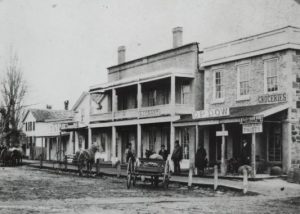 that they might as well make the best of it, and go fishing!!
that they might as well make the best of it, and go fishing!!
The captain told them that Trout found the worms particularly tasty, and hard to resist, especially in the muddy waters after a rainfall, so in very short order, the townspeople decided that it must have been Providence (another word for a gift from God) that brought the worms to their area so miraculously overnight, when trout fishing in the nearby lakes and streams was a universal pastime. So, after finding out about the worms value, I’m sure the people were a little more careful about where they were stepping, so they didn’t kill the worms that might help them catch more trout.
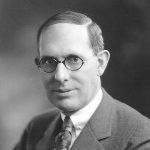 When the automobile first came out, driving them safely wasn’t the only difficulty. The early years of the automobile, found drivers using iron hand cranks to start the internal combustion process that powered the engines on their cars. Getting them started took great hand and arm strength, and the system was not without certain risks. Drivers who forgot to turn the ignition off before turning the crank, could be surprised when the car backfired or rolled forward. You may not know it, but at that time most vehicles had no brakes. Clearly a better system was needed, and in 1911 Cadillac head Henry M Leland gave Charles F Kettering the task of developing one. Kettering was the co-founder of Dayton Engineering Laboratories Company (DELCO) in Dayton, Ohio.
When the automobile first came out, driving them safely wasn’t the only difficulty. The early years of the automobile, found drivers using iron hand cranks to start the internal combustion process that powered the engines on their cars. Getting them started took great hand and arm strength, and the system was not without certain risks. Drivers who forgot to turn the ignition off before turning the crank, could be surprised when the car backfired or rolled forward. You may not know it, but at that time most vehicles had no brakes. Clearly a better system was needed, and in 1911 Cadillac head Henry M Leland gave Charles F Kettering the task of developing one. Kettering was the co-founder of Dayton Engineering Laboratories Company (DELCO) in Dayton, Ohio.
Before founding DELCO with his partner Edward Deeds in 1909, Kettering worked at the National Cash Register Company. While there, he helped develop the first electric cash register. I’m sure that was what called attention to him when Leland was looking for the right inventor for his project. Kettering drew on his experience with the cash register, when approaching his work with automobiles. The new invention wasn’t that big a leap from the cash register either. Just as the touch of a button had started a motor that opened the drawer of the cash register, Kettering would eventually use a key to turn on his self-starting motor. The self-starter was introduced in the 1912 Cadillac, patented by Kettering in 1915, when he was issued U.S. Patent No. 1,150,523 for his “engine-starting device,” the first electric ignition device for automobiles, on August 17, 1915.
The device worked so well that by the 1920s, it would come standard on nearly every new automobile. The device made cars easier and safer to operate, especially for women. The new self-starting engine was a huge hit, and caused a big jump in sales. The new engine was responsible for the fast-growing automobile culture in America. United Motors Corporation, which would become General Motors, bought DELCO in 1916. Kettering was the vice president and director of research at GM from 1920 to 1947. The self-starting engine wasn’t the only invention Kettering headed-up. Other important auto-related innovations developed during Kettering’s 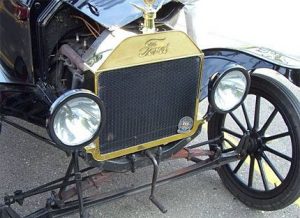 tenure were quick-drying automotive paint, spark plugs, leaded gasoline, shock absorbers, the automatic transmission, four-wheel brakes, the diesel engine and safety glass. He helped develop the refrigerant Freon, used in refrigerators and air conditioners, and the Kettering home in Dayton was the first in the country to be air-conditioned. In the realm of medicine, Kettering created a treatment for venereal disease and an incubator for premature infants, and in 1945 he and longtime General Motors head Alfred P Sloan established the Sloan-Kettering Institute for Cancer Research in New York City. Charles F Kettering died in 1958, having made great contributions toward the improvement of many lives.
tenure were quick-drying automotive paint, spark plugs, leaded gasoline, shock absorbers, the automatic transmission, four-wheel brakes, the diesel engine and safety glass. He helped develop the refrigerant Freon, used in refrigerators and air conditioners, and the Kettering home in Dayton was the first in the country to be air-conditioned. In the realm of medicine, Kettering created a treatment for venereal disease and an incubator for premature infants, and in 1945 he and longtime General Motors head Alfred P Sloan established the Sloan-Kettering Institute for Cancer Research in New York City. Charles F Kettering died in 1958, having made great contributions toward the improvement of many lives.
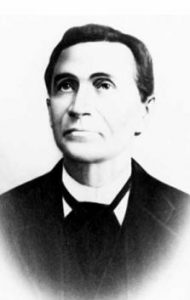 The other day, while reading an article about notable Native Americans, I came across a name that was familiar to me, but really didn’t seem like a Native American name. The name was Renville, the same name as my grand-nephew, James Renville. Immediately, I wondered if there might be a connection between Chief Gabriel Renville and my grand-nephew. The search didn’t take very long, before I had my answer. Gabriel Renville is my grand-nephew, James’ 1st cousin 7 times removed. I find that to be extremely amazing to think that James is related to an Indian chief. With that information, I wanted to fine out more abut this man.
The other day, while reading an article about notable Native Americans, I came across a name that was familiar to me, but really didn’t seem like a Native American name. The name was Renville, the same name as my grand-nephew, James Renville. Immediately, I wondered if there might be a connection between Chief Gabriel Renville and my grand-nephew. The search didn’t take very long, before I had my answer. Gabriel Renville is my grand-nephew, James’ 1st cousin 7 times removed. I find that to be extremely amazing to think that James is related to an Indian chief. With that information, I wanted to fine out more abut this man.
Chief Gabriel Renville was a mixed-blood Santee Sioux—his father was half French and his mother half-Scottish. He was born in April of 1825 at Big Stone Lake, South Dakota. Renville was the treaty chief of the Sisseton-Wahpeton Santee tribes and signed the 1867 treaty, which established the boundaries of the Lake Traverse Reservation. One source called him a Champion of Excellence.
He was careful to protect his people as much as he could, and was also instrumental in saving the lives of many white captives. During the 1862 Uprising, Renville opposed Little Crow and was influential in keeping many of the Santee out of the war. He lost a large amount of property, including horses appropriated by the hostile savages, or destroyed in consequence of his position to their murderous course. Renville served as chief of scouts for General Sibley during the campaign against the Sioux in 1863.
Even though Chief Renville was an ally of the whites, it didn’t help him when he settled on the reservation. The government agent there, Moses N. Adams, considered him hostile. Renville was the leader of the “scout party” which was in conflict with the “good church” Indians. I’m sure that was common in those days. Renville preserved many of the traditional Santee customs of polygamy and dancing, and he ignored Christianity, but he 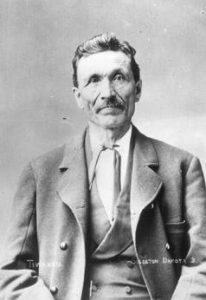 was not opposed to economic progress and he and his followers became successful farmers on the reservation. However, the Sisseton agent favored the “church” Indians.
was not opposed to economic progress and he and his followers became successful farmers on the reservation. However, the Sisseton agent favored the “church” Indians.
Renville and other leaders of the traditional Indians accused Adams of discriminating against them in the disposition of supplies and equipment. He said Adams favored the idle church-goers instead of encouraging them to work….a situation not unlike the current welfare system. Agent Adams considered Renville a detriment and removed the chief form the reservation executive board which Adams had organized to carry out his policies. It was a move that was considered extreme. In 1874 Renville was finally successful in securing a government investigation of the Adam’s activities. The outcome of the investigation was an official censure of Adams. Chief Renville continued to practice the old Santee customs, yet he encouraged the Indians to farm. This progressive influence was greatly missed after his death in August 1892.
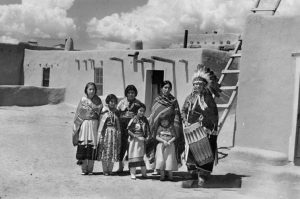 Most often, when we think of the early Americans, and their settlements, we think about the settlers who came over from Europe, but there were, of course, the many Indian tribes that existed here first. I’m not going to dispute whether the Indians or the White Man have more right to be here, because I truly believe that we should all be able to co-exist here after all these years, and that while treaties were broken many times, we have more than likely paid for this land a number of times, given the money that has been, and continues to be paid to the Native Americans. The oldest known culture in the United States was the Pueblo Indians, who lived in the Southwestern United States. Their name is Spanish for “stone masonry village dweller.” They are believed to be the descendants of three major cultures…the Mogollon, Hohokam, and Ancient Puebloans (Anasazi) Indians. I’m not sure how they would have come to be here, unless their ancestors were here first, but that is how the historians see it.
Most often, when we think of the early Americans, and their settlements, we think about the settlers who came over from Europe, but there were, of course, the many Indian tribes that existed here first. I’m not going to dispute whether the Indians or the White Man have more right to be here, because I truly believe that we should all be able to co-exist here after all these years, and that while treaties were broken many times, we have more than likely paid for this land a number of times, given the money that has been, and continues to be paid to the Native Americans. The oldest known culture in the United States was the Pueblo Indians, who lived in the Southwestern United States. Their name is Spanish for “stone masonry village dweller.” They are believed to be the descendants of three major cultures…the Mogollon, Hohokam, and Ancient Puebloans (Anasazi) Indians. I’m not sure how they would have come to be here, unless their ancestors were here first, but that is how the historians see it.
Over the years, the Ancient Puebloans, who had been a nomadic, hunter-gathering society, evolved into a sedentary culture. They made their homes in the Four Corners region of Colorado, New Mexico, Utah and Arizona. The Puebloans continued to hunt, but they also expanded to agriculture. They grew maze, corn, squash, and beans. They also raised turkeys and even developed a fairly complex irrigation system. They took up basket weaving and pottery, and became quite skilled in both. About this time, they began building the 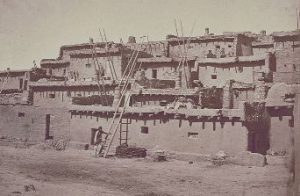 buildings we think about when we think of the Pueblo Indians…villages, often on top of high mesas or in hollowed-out natural caves at the base of canyons. These multiple-room dwellings and apartment like complexes, designed with stone or adobe masonry, were the forerunner of the later pueblos.
buildings we think about when we think of the Pueblo Indians…villages, often on top of high mesas or in hollowed-out natural caves at the base of canyons. These multiple-room dwellings and apartment like complexes, designed with stone or adobe masonry, were the forerunner of the later pueblos.
Sadly, even with their successful life changes, the Ancient Puebloans way of life declined in the 1300’s, probably due to drought and inter-tribal warfare. They migrated south, primarily into New Mexico and Arizona, becoming what is today known as the Pueblo people. For hundreds of years, these Pueblo descendants lived a similar lifestyle to their ancestors. They continued to survive by hunting and farming, and also building “new” apartment-like structures, sometimes several stories high. These new structures were made of cut sandstone faced with adobe, which is a combination of earth mixed with straw and water. Sometimes, the adobe was poured into forms or made into sun-dried bricks to build walls that are often several feet thick. The buildings had flat roofs, which served as working or resting places, as well as observation points to watch for approaching enemies and view ceremonial occasions. For better defense, the outer walls generally had no doors or windows, but instead, window openings in the roofs, with ladders leading into the interior.
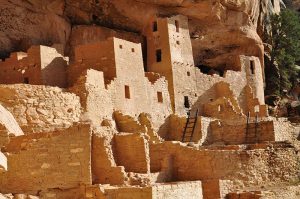 Each family unit consisted of a single room of the building unless the family grew too large. Then side-rooms were sometimes added. The houses of the pueblo were usually built around a central, open space or plaza in the middle of which was a “kiva,” a sunken chamber used for religious purposes. Each pueblo was an independent and separate community. The different pueblos shared similarities in language and customs, but each pueblo had its own chief, and sometimes two chiefs, a summer and winter chief, who alternated. Most important affairs, such was war, hunting, religion, and agriculture, however, were governed by priesthoods or secret societies. Each pueblo was almost a separate country.
Each family unit consisted of a single room of the building unless the family grew too large. Then side-rooms were sometimes added. The houses of the pueblo were usually built around a central, open space or plaza in the middle of which was a “kiva,” a sunken chamber used for religious purposes. Each pueblo was an independent and separate community. The different pueblos shared similarities in language and customs, but each pueblo had its own chief, and sometimes two chiefs, a summer and winter chief, who alternated. Most important affairs, such was war, hunting, religion, and agriculture, however, were governed by priesthoods or secret societies. Each pueblo was almost a separate country.
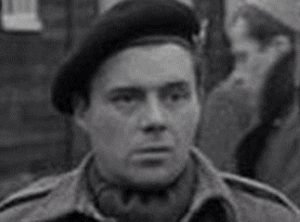 The term “coward” doesn’t normally bring with it thoughts of bravery in the face of danger, but perhaps it should…sometimes anyway. Charles Joseph Coward was born in Britain on January 30, 1905. I can’t say what his young life was like, and perhaps it was his parents who taught him to prove his name wrong, but I’m quite sure they were proud of just how well he proved that he was anything, but a coward. Coward joined the British Army in 1937 and served with the 8th Reserve Regimental Royal Artillery. By the time WWII started in 1939, he was a Quartermaster Battery Sergeant Major. They already saw something in him that disproved his name.
The term “coward” doesn’t normally bring with it thoughts of bravery in the face of danger, but perhaps it should…sometimes anyway. Charles Joseph Coward was born in Britain on January 30, 1905. I can’t say what his young life was like, and perhaps it was his parents who taught him to prove his name wrong, but I’m quite sure they were proud of just how well he proved that he was anything, but a coward. Coward joined the British Army in 1937 and served with the 8th Reserve Regimental Royal Artillery. By the time WWII started in 1939, he was a Quartermaster Battery Sergeant Major. They already saw something in him that disproved his name.
In World War II, Coward was fighting against the Nazis when the Germans assaulted the port of Calais on May 21, 1940, marking the start of the Siege of Calais. The German army drove the Allies back, and the British Expeditionary Force fled from France through the port of Dunkirk. Fortunately, most made it out in time…to fight the Germans another day. Unfortunately for Coward, he was not one of them, and he became a POW. He did have an advantage, however, in that he spoke German. He used his language skills to make seven escape attempts by passing himself off as a German soldier. One of the escape attempts worked. He was free, but he was injured, and was sent to a German Army field hospital. Coward kept up his German soldier act. After the German doctors had treated his wounds, he was awarded an Iron Cross for his bravery and suffering. Unfortunately, they realized their mistake pretty quickly. Coward was sent back to the POW camp where he earned a reputation for sabotage while on work details. Finally, he was sent to Poland…Auschwitz, to be precise…not to the death camp part of Auschwitz, but rather to the work camp part of it. Coward arrived at Auschwitz III (Monowitz), which was the working camp, in December 1943. The camp was located approximately five miles from Auschwitz II (Birkenau), which was the death camp. There he became a modern day “Hogan’s Hero,” although there was nothing funny about his situation, like there was in the television show. Coward spied on his captors and risked his life to save those he could. All that under the name of Coward.
IG Farben was a German chemical and pharmaceutical industry conglomerate. Its name was taken from Interessen-Gemeinschaft Farbenindustrie. IG Farben had acquired the patent to Zyklon B. It was originally used as an insecticide and by US immigration officials to delouse Mexican laborers. The Nazis had a different use for it…the extermination of Jews and other undesirables. Coward and between 1,200 and 1,400 other British POWs were kept at sub-camp E715. Their job was to run the liquid fuel plant which produced synthetic rubber. Coward, due to his German language skills worked as a Red Cross liaison officer, because Germany was still keeping up the pretense of honoring the Geneva Convention articles. He was allowed some measure of free movement within the camp, and even permitted to go to the nearby towns. In town, Coward saw trainloads of Jews arriving at the the extermination camp. Auschwitz III housed 10,000 Jews who were “allowed” to work. They were worked to the point of exhaustion and sickness. Given the brutality and deliberate starvation they did not last long. Coward simply couldn’t stand by and do nothing. The British POWs had access to Red Cross items, so Coward and the other prisoners set aside food and medicine to be smuggled to the Jewish section of their camp, to help as many as possible. Coward was allowed to send letters out, so he began writing to his friend…Mr. William Orange, a fictitious person. It was actually the code for the British War Office. In those letters, he explained what was happening in the camps, as well as the treatment and mass slaughter of Jews. One day, a letter was smuggled to him, asking for help. It came from Karel Sperber, a British ship’s doctor, but there was a problem…Sperber was being held in the Jewish section of Monowitz. So Coward exchanged clothes with an inmate and smuggled himself into the Jewish sector to try to find the doctor. Sadly, he failed, but he did see how Jews in the work camp were being treated. After the war, he was among those who testified at the IG Farben Trial in Nuremberg. He helped to have some of the company’s directors imprisoned, although only for a few years.
He wanted to help the Jews, but to pull it off, he needed two things…chocolate and corpses. It was a daring plan, but it worked. Coward gave the chocolate to the guards in exchange for the bodies of non-Jewish dead prisoners. Then, once their clothes and papers had been removed they were cremated. Jewish escapees put on the clothes and assumed the new, non-Jewish identities. With help from members of the Polish resistance, they were then smuggled out of the camp. As the number of those missing tallied with the number of those who were reported dead, neither Coward nor the bribed guards fell under any suspicion. It is estimated around 400 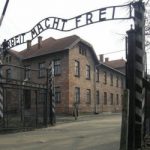
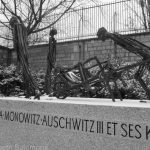 Jews were saved using Coward’s method. In January 1945 Soviet forces advanced deeper into Poland. As they made their way toward Auschwitz, Coward and the other POWs were forced to march to Bavaria in Germany. The prisoners were liberated by Allied forces en route, finally putting an end to the brutal nightmare. In 1963 Yad Vashem recognized Coward as one of the Righteous Among the Nations. He became known as the “Count of Auschwitz.” and a film was made of his exploits called “The Password is Courage.” I think he was a pretty brave man…for a Coward.
Jews were saved using Coward’s method. In January 1945 Soviet forces advanced deeper into Poland. As they made their way toward Auschwitz, Coward and the other POWs were forced to march to Bavaria in Germany. The prisoners were liberated by Allied forces en route, finally putting an end to the brutal nightmare. In 1963 Yad Vashem recognized Coward as one of the Righteous Among the Nations. He became known as the “Count of Auschwitz.” and a film was made of his exploits called “The Password is Courage.” I think he was a pretty brave man…for a Coward.
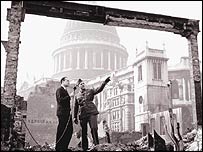 In March or 1941, the United States was largely considered neutral, so we could provide the countries, who were fighting Adolf Hitler, with war material. It was during this period of time, that the United Kingdom, an old enemy of the United States, since the United States fought against them for our independence, needed our help. Of course, we were allies by that time, and so the thought of a loan to the UK was not out o the question. The UK had been fighting against Adolf Hitler’s Germany army for a while by then, and funds were dwindling. The US loaned $4.33 billion to Britain in 1945, while Canada loaned US$1.19 billion in 1946, at a rate of 2% annual interest. It was a good deal, but in the end, the amount paid back was nearly double the amounts loaned in 1945 and 1946.
In March or 1941, the United States was largely considered neutral, so we could provide the countries, who were fighting Adolf Hitler, with war material. It was during this period of time, that the United Kingdom, an old enemy of the United States, since the United States fought against them for our independence, needed our help. Of course, we were allies by that time, and so the thought of a loan to the UK was not out o the question. The UK had been fighting against Adolf Hitler’s Germany army for a while by then, and funds were dwindling. The US loaned $4.33 billion to Britain in 1945, while Canada loaned US$1.19 billion in 1946, at a rate of 2% annual interest. It was a good deal, but in the end, the amount paid back was nearly double the amounts loaned in 1945 and 1946.
The United States was pulled into World War II shortly after, when Japan attacked Pearl Harbor. That marked to end of the program to provide military materials, because the United States was no longer considered neutral. At this point, the United States was very much needed in a very different way, and could not be neutral and be an effective help, but they also had a score to settle, and it could not be handled on the sidelines. The United States had hoped to sit this one out, but that was not to be. The Axis of Evil was winning against the Allied Nations, and they needed help, but it was the boldness of the attack on Pearl Harbor that finally awoke the sleeping giant that was the United States. The United States victory over Japan in the Battle of Midway was the turning point of the war in the Pacific. Then Germany invaded the Soviet Union. The Soviet Union defeated Germany at Stalingrad, marking the turning point of the war in Eastern Europe. As we all know, in the end the Allies were victorious in World War II.
There are still World War I debts owed to and by Britain. Since a moratorium on all debts from that conflict was agreed at the height of the Great Depression, no repayments have been made to or received from other nations since 1934. Despite the favorable rates there were six years in which Britain deferred payment because of economic or political crises. Britain settled its World War II debts to the United States and Canada when it paid the final  two installments in 2006. The payments of $83.25 million to the US and US$22.7 million to Canada are the last of 50 installments since 1950. Upon the final payments, the UK will have paid back a total of $7.5 billion to the US and US$2 billion to Canada. “This week we finally honor in full our commitments to the United States and Canada for the support they gave us 60 years ago,” said Treasury Minister Ed Balls at the time of those final payments. “It was vital support which helped Britain defeat Nazi Germany and secure peace and prosperity in the post-war period. We honor our commitments to them now as they honored their commitments to us all those years ago,” he added.
two installments in 2006. The payments of $83.25 million to the US and US$22.7 million to Canada are the last of 50 installments since 1950. Upon the final payments, the UK will have paid back a total of $7.5 billion to the US and US$2 billion to Canada. “This week we finally honor in full our commitments to the United States and Canada for the support they gave us 60 years ago,” said Treasury Minister Ed Balls at the time of those final payments. “It was vital support which helped Britain defeat Nazi Germany and secure peace and prosperity in the post-war period. We honor our commitments to them now as they honored their commitments to us all those years ago,” he added.
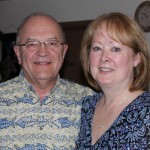
 During our visit to Superior, Wisconsin, my sister, Cheryl Masterson; her daughter, Liz Masterson; and I were treated a couple of wonderful tours of the area. Our cousin, Pam Wendling and her husband Mike took us down to Canal Park, where we watched the Paul R Tragurtha coming into port to pick up a load of coal…that come to Duluth by train from none other than Gillette, Wyoming, by the way. The Paul R Tragurtha is known as the “Queen of the Lakes” and is the longest vessel on the Great Lakes at 1,013 feet 6 inches. Watching that great ship come into port is amazing. It was also great to have Pam and Mike there to give us the lake and ship history. Though we had been to Canal Park before, it just never gets old.
During our visit to Superior, Wisconsin, my sister, Cheryl Masterson; her daughter, Liz Masterson; and I were treated a couple of wonderful tours of the area. Our cousin, Pam Wendling and her husband Mike took us down to Canal Park, where we watched the Paul R Tragurtha coming into port to pick up a load of coal…that come to Duluth by train from none other than Gillette, Wyoming, by the way. The Paul R Tragurtha is known as the “Queen of the Lakes” and is the longest vessel on the Great Lakes at 1,013 feet 6 inches. Watching that great ship come into port is amazing. It was also great to have Pam and Mike there to give us the lake and ship history. Though we had been to Canal Park before, it just never gets old.
Pam and Mike also took us up the North Shore of Lake Superior to Two Harbors, Minnesota, and showed us all the 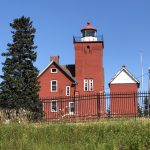
 sights in that area. The lighthouse there is really pretty, and we were able to get lots of pictures. There was a ship in the harbor that was loading Taconite, which is a low-grade iron ore. For a long time, when the high-grade natural iron ore was plentiful, Taconite was considered a waste rock and not used. Then, as the supply of high-grade natural ore decreased, industry began to view Taconite as a resource. Had it not been for Mike’s knowledge of all these mining, railroad, and shipping industries in the area, and in the United States, we would have seen these things, but really wouldn’t have know anything about the rich history that went along with it. It takes someone, like Mike, with a love of history to give us that.
sights in that area. The lighthouse there is really pretty, and we were able to get lots of pictures. There was a ship in the harbor that was loading Taconite, which is a low-grade iron ore. For a long time, when the high-grade natural iron ore was plentiful, Taconite was considered a waste rock and not used. Then, as the supply of high-grade natural ore decreased, industry began to view Taconite as a resource. Had it not been for Mike’s knowledge of all these mining, railroad, and shipping industries in the area, and in the United States, we would have seen these things, but really wouldn’t have know anything about the rich history that went along with it. It takes someone, like Mike, with a love of history to give us that.
Pam and Mike also do some hiking in the area, and we were shown some of the beautiful hiking trails, and the 
 beautiful wooded areas around the lake. The streams and waterfalls especially appealed to us. That area has so many more trees that we have in Wyoming, and all that greenery made me long to get out and wander down the trail, but we just didn’t have the time, unfortunately. Pam suggested that Bob and I consider a hiking trip to the area, we may have to try to do that. The tours were beautiful, and the time we spent with them was very special to us. I am so glad that we have reconnected with all of our cousins in the Superior/Duluth area, and all over the nation. Amazing family connections.
beautiful wooded areas around the lake. The streams and waterfalls especially appealed to us. That area has so many more trees that we have in Wyoming, and all that greenery made me long to get out and wander down the trail, but we just didn’t have the time, unfortunately. Pam suggested that Bob and I consider a hiking trip to the area, we may have to try to do that. The tours were beautiful, and the time we spent with them was very special to us. I am so glad that we have reconnected with all of our cousins in the Superior/Duluth area, and all over the nation. Amazing family connections.

